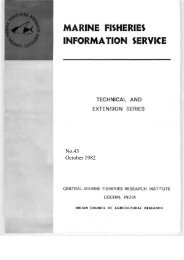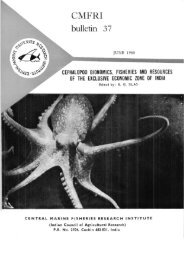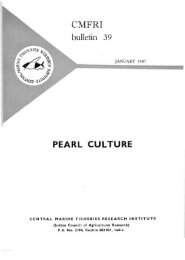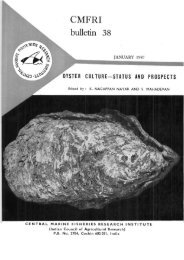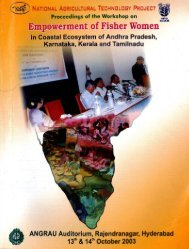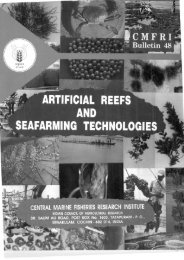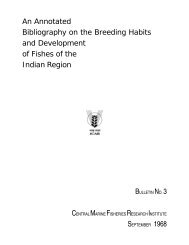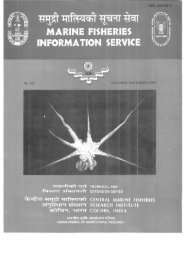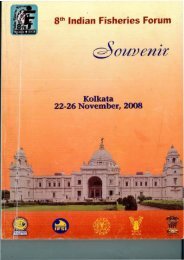Marine Fisheries Information Service - Eprints@CMFRI - Central ...
Marine Fisheries Information Service - Eprints@CMFRI - Central ...
Marine Fisheries Information Service - Eprints@CMFRI - Central ...
Create successful ePaper yourself
Turn your PDF publications into a flip-book with our unique Google optimized e-Paper software.
8 <strong>Marine</strong> <strong>Fisheries</strong> <strong>Information</strong> <strong>Service</strong> T&E Ser., No. 196, 2008<br />
18,00,000 numbers. Juveniles of other species like<br />
silverbellies and croakers are also observed in the<br />
catch but their period of occurrence does not coincide<br />
with that of mackerel and seerfish. As of now, these<br />
young ones do not fetch money and are either<br />
discarded at the landing site itself or beach dried and<br />
mixed with other ingredients during the process of<br />
fish/chicken feed preparation.<br />
Shore seines are operated very close to the<br />
shore and unlike in other operations, the fishes caught<br />
are alive and active when the net is dragged above<br />
the water level. Presently there is no restriction on<br />
the season of operation as well as mesh size to be<br />
used in the operation of shoreseines, hence operation<br />
will continue and huge quantities of young ones will<br />
be destroyed annually. An alternate beneficial long<br />
term solution to this problem may be to officially<br />
recognize these gears as natural seed collectors of<br />
these commercially important fish species during the<br />
couple of months when juveniles are abundantly<br />
available. This will ensure that the young ones get a<br />
better price and are beneficially used for culture<br />
purposes. The <strong>Central</strong> <strong>Marine</strong> <strong>Fisheries</strong> Research<br />
Institute has already demonstrated techniques of cage<br />
culture for the large scale rearing of marine finfishes<br />
at Visakhapatnam. Cage culture is fast catching up<br />
as the most effective method for the rearing of marine<br />
fishes. The availability of commercially important<br />
seeds in good quantities as indicated in the present<br />
survey can be gainfully utilized for this purpose until<br />
suitable technology for seed production of such high<br />
valued fishes is developed.<br />
Line fishing is used to catch the coastal, offshore<br />
and oceanic fishes. These are mostly operated by<br />
non-mechanized crafts though motorization is slowly<br />
gaining popularity since the last couple of years. The<br />
longlines are operated at depths ranging from 30 m<br />
to 300 m depending on the type of fish targeted. The<br />
lines operated at lower depths generally target coastal<br />
tunas, seerfish, snappers, leather jackets and flying<br />
fishes. These longlines have a mainline of a total<br />
length ranging from 300-1000 m with 100-600 hooks<br />
attached to it from branch lines. The hook numbers<br />
used here range from 4-12. The units operating for<br />
larger oceanic fishes especially yellowfin tunas,<br />
sailfishes and kingseer use hook numbers one or two.<br />
The number of hooks per line is also limited to 25-30<br />
numbers. Trolling is equally popular for hooking the<br />
oceanic large sized fishes. These are operated<br />
beyond 200 m and the hook numbers used are one,<br />
two or four. Details of hook and lines used along<br />
Andhra Pradesh are given in Table 4.<br />
Fishing season<br />
Fishing is carried out throughout the year along<br />
the Andhra coast. However, a seasonal trend is<br />
followed by the different gears. Moreover as a<br />
measure to conserve the fishery, there is a fishing<br />
Table 4. Details of lines operated along Andhra Pradesh<br />
Length of Length of No. of Hook Hook Depth of Period of Target species<br />
mainline branch line hooks type no. operation operation<br />
(m) (m) (m)<br />
2000 10 100 Round bent 1 >100 Throughout Tunas, billfish,<br />
the year seerfish, sharks<br />
88 9 5 Round bent 2 >100 Throughout Sharks, tunas,<br />
the year billfish, dolphinfish<br />
300 5 30 Round bent 4 >100 Throughout Tunas, seerfish,<br />
the year billfish<br />
70 0.5 20 Round bent 9




